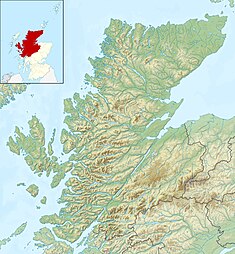Our website is made possible by displaying online advertisements to our visitors.
Please consider supporting us by disabling your ad blocker.
Kerry Falls Hydro-Electric Scheme
| Kerry Falls Hydro-Electric Scheme | |
|---|---|
 Loch Bad an Sgalaig Dam impounds the water supply for the power station | |
| Country | Scotland |
| Location | Gairloch, Wester Ross |
| Coordinates | 57°41′07″N 5°38′37″W / 57.6852°N 5.6435°W |
| Purpose | Power |
| Status | Operational |
| Opening date | 1952 |
| Owner(s) | SSE |
Kerry Falls Hydro-Electric Scheme | ||||||||||||||||||||||||||||||||||||||||||||||||||||||||||||||||||||||||||||||||||||||||||||||||||||||||||||||||||||||||||||||||||||||||||||||||||||||||||||||||||||||||||||||||||||||
|---|---|---|---|---|---|---|---|---|---|---|---|---|---|---|---|---|---|---|---|---|---|---|---|---|---|---|---|---|---|---|---|---|---|---|---|---|---|---|---|---|---|---|---|---|---|---|---|---|---|---|---|---|---|---|---|---|---|---|---|---|---|---|---|---|---|---|---|---|---|---|---|---|---|---|---|---|---|---|---|---|---|---|---|---|---|---|---|---|---|---|---|---|---|---|---|---|---|---|---|---|---|---|---|---|---|---|---|---|---|---|---|---|---|---|---|---|---|---|---|---|---|---|---|---|---|---|---|---|---|---|---|---|---|---|---|---|---|---|---|---|---|---|---|---|---|---|---|---|---|---|---|---|---|---|---|---|---|---|---|---|---|---|---|---|---|---|---|---|---|---|---|---|---|---|---|---|---|---|---|---|---|---|
| ||||||||||||||||||||||||||||||||||||||||||||||||||||||||||||||||||||||||||||||||||||||||||||||||||||||||||||||||||||||||||||||||||||||||||||||||||||||||||||||||||||||||||||||||||||||
Kerry Falls Hydro-Electric Scheme, sometimes known as Gairloch is a small-scale hydro-electric power station, built by the North of Scotland Hydro-Electric Board and commissioned in 1952. It is located near Gairloch in Wester Ross, part of the Highlands of Scotland. It was originally designed to supply power to local communities in this remote area, but is now connected to the National Grid.
The River Kerry below the power station is a Special Area of Conservation, due to the presence of an internationally important population of freshwater pearl mussels. It also hosts populations of salmon and trout, without which the mussels could not reproduce. The hydro-electric scheme is thought to contribute to the success of the mussels, as Loch Bad an Sgalaig traps silt, which if deposited on gravel beds can suffocate mussels and fish embryos. The flow on the river is also relatively stable for long periods, although subject to step changes when turbines are switched on or off, and flows are maintained throughout the year, enabling salmon and trout to enter the river.
Previous Page Next Page



